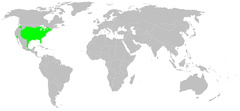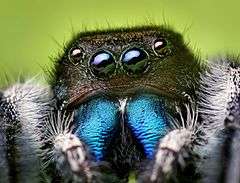Phidippus audax
Phidippus audax is a common jumping spider of North America. It is commonly referred to as the daring jumping spider, or bold jumping spider. The spider belongs to the genus Phidippus, a group of jumping spiders easily identified both by their relatively large size and their iridescent chelicerae.
| Phidippus audax | |
|---|---|
 | |
| Female in Columbia County, Florida | |
 | |
| Male in Columbia County, Florida | |
| Scientific classification | |
| Kingdom: | Animalia |
| Phylum: | Arthropoda |
| Subphylum: | Chelicerata |
| Class: | Arachnida |
| Order: | Araneae |
| Infraorder: | Araneomorphae |
| Family: | Salticidae |
| Genus: | Phidippus |
| Species: | P. audax |
| Binomial name | |
| Phidippus audax (Hentz, 1845) | |
 | |
| Synonyms | |
Like other jumping spiders, due to their large, forward-facing eyes, they have very good stereoscopic vision. This aids them when stalking prey, and allows some visual communication with others of their species, such as courting 'dances'.
Description
Phidippus audax varies widely in size and coloration.[1] Adult males range from 4–15 millimeters in body length, with an average of 8 mm. Adult females range from 4–18 millimeters in body length, with an average of 11 mm.[1] They are typically black with a pattern of spots and stripes on their abdomen and legs. Often these spots are orange-tinted in juveniles, turning white as the spider matures. However, in some parts of Florida it is common for adults to have yellow, orange, or red spots.[1] The chelicerae (mouthparts) are a bright, metallic green or blue.
Habitat

Like most jumping spiders, P. audax tends to prefer relatively open areas to hunt in, as they actively seek and stalk prey and do not build webs to catch food. They do use webbing, however, only when laying eggs or to hide. They also use spider silk as a 'lifeline' when jumping for prey or evading predators.
They are common in fields and grasslands, and are frequently seen on fences, exterior walls, and gardens as well. Many jumping spiders seem to prefer flat vertical surfaces, likely because it enables them to spot and chase down roaming insects with ease.
Distribution
This species is common in southern Canada, throughout the United States and parts of northern Mexico, plus Cuba, and has been introduced to Hawaii and the Nicobar Islands.
Name
P. audax is the type species for the genus Phidippus. The species name is derived from the Latin word audax meaning "daring, audacious".
Bites
Like most spiders, P. audax rarely bites humans. While symptoms of a bite may vary, the most likely symptoms are pain, itching, swelling and redness with a duration of 1 to 2 days.[2]
References
- Edwards, Glavis B. (2004). Revision of the jumping spiders of the genus Phidippus (Araneae, Salticidae). Florida Department of Agriculture and Consumer Services. pp. 72–76.
- "Bold Jumper Spider". Penn State Department of Entomology. Retrieved March 6, 2020.
- Entomology Department at the University of Arkansas
- Platnick, Norman I. (2009): The world spider catalog, version 9.5. American Museum of Natural History.
External links
| Wikimedia Commons has media related to Phidippus audax. |
- David Edwin Hill: Portrait of feeding female Phidippus audax — Video
- Daring Jumping Spider Reference quality diagnostic photos
- Diagnostic drawings
- Pictures of P. audax (free for noncommercial use)